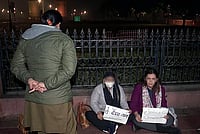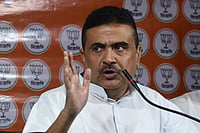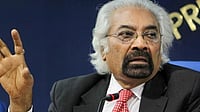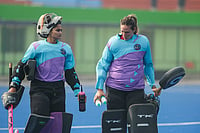Expensive labs and equipment are out, so Gupta’s syllabus demands only ‘Ten Little Fingers’, retrieved rubbish and the free spirit of discovery to learn about complex scientific concepts. A national award-winner for science popularisation among children, particularly among the poor and underprivileged, Gupta’s classes are often held in the outdoors. And he needs only matchboxes, broomsticks and slippers to explain everyday phenomena like light and its daunting laws of convergence and divergence. Taking an old rubber sole (he says Bata’s hawai slippers are the best) planted with three old ballpens, the kids merely bend the sole forward till the pens touch each other, like rays of light in focus, and then bend it backwards until the pens split into separate rays to demonstrate divergence. "It is nothing but hocus-pocus," he says, but for most kids the ‘slipper-flipper’ is a simple, fun experiment whose results are unforgettable.
These simple science kits also attempt to minimise the impact of eco-disastrous products like tetrapacks by finding new uses for them after they’ve been junked. Expensive and energy-demanding to produce, the real problem with tetrapacks kicks in once the Frooti or Dhara is over, for there is simply no way to get rid of them. So, old tetrapacks thoughtlessly flung away become long-life measuring cylinders, funnels or tree name-plates. Empty plastic film roll cans are recycled into ‘pumps from the dump’. "Almost 60 per cent of India depends on handpumps," says Gupta, "but did you know a world-class pump with working valves can be made in ten minutes using a film roll can and an Add Gel refill?" What’s more they are leak-proof, so these home-made pumps can pass the same acid test used to evaluate commercially produced pumps.
So too with geometry, the onset of which is signalled for rich kids by the purchase of a prized Camel geometry box, used to measure points and angles, an option unaffordable for many. To circumvent the price factor, Gupta uses a babool thorn: "It’s a suitable divider that can be had from the outdoors for free." Likewise, straw and wool, used to explain the principles of sound, have a side benefit—"blowing through the straw to observe what happens to the pitch as the straw is snipped simultaneously helps increase the lung power of asthmatic kids". So he’s developed a money-saving and eco-friendly curriculum, but what made this Indian Institute of Technology, Kanpur alumnus turn to teaching science in the first place?
"I was on study leave from telco in 1978, when I got involved in the Hoshangabad Science Project run by Dr Anil Sadgopal. The delight in developing cheap scientific experiments was addictive". It was enough to convince Gupta that a greater future lay in sharing the joy of science. "One of the biggest problems is that even among the brightest minds there are few takers for the pure sciences. The way it is taught in India does not enthuse anyone. Today, seeing the eyes of kids light up with discovery means far more to me..."<
In these 25-odd years, 70 of Gupta’s films on science and teaching have been telecast on Doordarshan. He has published 11 books, largely through the National Book Trust. Matchstick Models (first edition 1978) has sold half a million copies and been translated into 13 languages and is in its 11th Malayalam edition. To bring significant works to the 40-crore Hindi-speaking population, he has translated 75 books on learning and life. That’s quite a journey for a man who took a U-turn in life so he could enjoy himself while putting the fizz back into physics. To find out more, contact: Arvind Gupta, C7/167, Safdarjung Development Area, New Delhi 110 016; e-mail: arvindguptatoys@hotmail.com
























